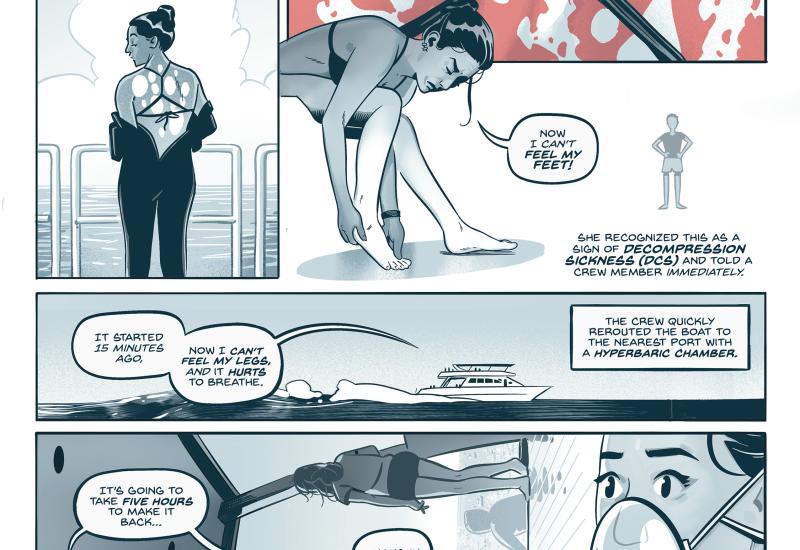Are Dive Training Requirements Adequate?
Current training standards work with performance-based learning
By H. Kelly Levendorf
As I approached my 16th birthday and my first set of car keys, I chose Driver’s Ed as an elective, not Auto Shop. After all, I wanted to learn to drive, not study internal combustion mechanics. Ironically, just three years later, when I wanted to learn to dive, I was required to learn Boyle’s Law before I was ever allowed to don mask and fins in the pool. My original certification course took nine weeks.
Divers — they don’t make ’em like they used to. That does not mean, however, that we’re training substandard divers. Although teaching methods have changed dramatically over the past 30 years, one tenet remains: Student divers need ample time for practice and mastery. As instructors, we must focus on performance-based –– not time-based –– learning.
Much has been written and even more said about the adequacy of today’s teaching standards. As instructor-trainers, we teach candidates to utilize an integrated system that provides flexibility in accommodating both group dynamics and individual learning styles. At Pro Dive we do not teach minimum requirements, nor do we teach instructors to accept them from their own students. There is no question the divers of the 21st century have enjoyed a cultural shift to independent study and online learning. Rather than bemoan the lessening of time in the classroom, instructors should embrace the additional time it provides, to teach where it is most valuable: in the water. Properly used, today’s modular training can maximize aquatic proficiency while still maintaining academic validity.
It’s all about the skills –– instructional and dive-related alike. Simply high-fiving students who have successfully cleared their masks one time isn’t a measure of skill mastery. With the extra pool time that independent study and prescriptive teaching allows, we must encourage repetition and variance in skills: Our students should clear their masks while they’re demonstrating neutral buoyancy, just as they’ll ultimately do while diving in the open water. Similarly, we need to drill in the appropriate means of, say, dealing with an out-of-air emergency; but more important, we must teach divers to continually monitor their gauges to prevent an out-of-air situation in the first place. The consummate instructor understands there isn’t always a single “right” way to perform a skill; it is our job to encourage divers to capitalize on their strengths and recognize their limitations. With this tactic, we teach problem avoidance as well as problem resolution.
Regardless of agency affiliation and regardless of classroom versus e-learning, today’s instructors have the greatest flexibility in preparing their students for the aquatic world. And today’s students have unparalleled ease in learning to dive. That does not mean they get to take the easy way out. If students are not trained properly, it is the inadequacy of the trainer, not the training standard, which is to blame.
H. Kelly Levendorf is chief development officer of Pro Dive International (www.prodiveusa.com ) in Fort Lauderdale. A PADI Master Instructor, he has taught since 1982 and logged more than 5,000 dives.
Today’s entry-level scuba training doesn’t teach real-world emergencies
By Bob Brayman
When I think about today’s training standards, I think back to an old Wendy’s commercial. You probably remember it: A little old lady looked at a Wendy’s competitor’s hamburger and asked, “Where’s the beef?” It became a funny slogan. As a result of that ad, we all started looking closer at the beef content of hamburgers. We made sure we didn’t get fooled into believing that what we thought was a beefy hamburger was just a hamburger with a lot of filler and not much real meat at all.
A similar comparison can be made to the training content of today’s entry-level courses. Instead of asking, “Where’s the beef?” today they would ask, “Where’s the deep?” Today’s entry-level course standards limit consumers to no deeper than 60 feet. Before it was the sport-diving limit of 130 feet. What happened? Where did the training go that took us from 60 feet to 130? Did the courses become shorter?
The courses didn’t become shorter; the restrictions became shallower. Why? The content became less. Like the hamburger slogan, less beef equals more filler. The courses became easier by requiring fewer skills. In particular, all the skills needed to take you safely from depths greater than 60 feet in an out-of-air situation are gone from most of today’s entry-level courses. I say most because we still teach them here at the Institute. The instructors who graduate from our Institute can teach them too. But the average entry-level course doesn’t contain them.
A consumer taught in today’s entry-level course loses the opportunity to safely enter the world of 61 feet and beyond without additional training. But wait a minute. Don’t people dive to depths greater than 60 feet after they learn to dive? Don’t I see pictures of people diving walls in exotic warm-water locations without additional training? Sure you do. Aren’t these people safe? Not really. They think they are. Why? Because nobody told them they weren’t. They assumed that the emergency swimming ascent or octopus-kicking ascent they learned in their entry-level course would work in deeper water. It won’t.
It’s not possible to safely kick to the surface doing the standard out-of-air emergency skills with negative buoyancy produced by wetsuit compression in deep water. You can be up to 15 to 20 pounds negative wearing a full wetsuit in deep water. “Aren’t divers supposed to be neutrally buoyant when they dive?” people ask. Yes, but they aren’t supposed to run out of air, either. It’s a mistake. The training should be in our entry-level class. The alternative for those who believed they were safe can be unfortunate. Do they deserve this? No.
Take out some filler. Add the emergency training. Rename a new agency entry-level course by adding “100” to the title and we prevent some unfortunate incidents. We do it at the Institute. It should be worldwide. “Open Water 100,” “Scuba Diver 100” –– what a concept! Care enough to build a better hamburger? That’s the one people will want to buy. In the meantime, “Where’s the deep?”
Bob Brayman is owner and operator of the International Diving Career Institute at Hall’s ( www.hallsdiving.com ), which has taught diving vocational courses on a daily basis for more than 30 years.
Current training standards work with performance-based learning
By H. Kelly Levendorf
As I approached my 16th birthday and my first set of car keys, I chose Driver’s Ed as an elective, not Auto Shop. After all, I wanted to learn to drive, not study internal combustion mechanics. Ironically, just three years later, when I wanted to learn to dive, I was required to learn Boyle’s Law before I was ever allowed to don mask and fins in the pool. My original certification course took nine weeks.
Divers — they don’t make ’em like they used to. That does not mean, however, that we’re training substandard divers. Although teaching methods have changed dramatically over the past 30 years, one tenet remains: Student divers need ample time for practice and mastery. As instructors, we must focus on performance-based –– not time-based –– learning.
Much has been written and even more said about the adequacy of today’s teaching standards. As instructor-trainers, we teach candidates to utilize an integrated system that provides flexibility in accommodating both group dynamics and individual learning styles. At Pro Dive we do not teach minimum requirements, nor do we teach instructors to accept them from their own students. There is no question the divers of the 21st century have enjoyed a cultural shift to independent study and online learning. Rather than bemoan the lessening of time in the classroom, instructors should embrace the additional time it provides, to teach where it is most valuable: in the water. Properly used, today’s modular training can maximize aquatic proficiency while still maintaining academic validity.
It’s all about the skills –– instructional and dive-related alike. Simply high-fiving students who have successfully cleared their masks one time isn’t a measure of skill mastery. With the extra pool time that independent study and prescriptive teaching allows, we must encourage repetition and variance in skills: Our students should clear their masks while they’re demonstrating neutral buoyancy, just as they’ll ultimately do while diving in the open water. Similarly, we need to drill in the appropriate means of, say, dealing with an out-of-air emergency; but more important, we must teach divers to continually monitor their gauges to prevent an out-of-air situation in the first place. The consummate instructor understands there isn’t always a single “right” way to perform a skill; it is our job to encourage divers to capitalize on their strengths and recognize their limitations. With this tactic, we teach problem avoidance as well as problem resolution.
Regardless of agency affiliation and regardless of classroom versus e-learning, today’s instructors have the greatest flexibility in preparing their students for the aquatic world. And today’s students have unparalleled ease in learning to dive. That does not mean they get to take the easy way out. If students are not trained properly, it is the inadequacy of the trainer, not the training standard, which is to blame.
H. Kelly Levendorf is chief development officer of Pro Dive International (www.prodiveusa.com ) in Fort Lauderdale. A PADI Master Instructor, he has taught since 1982 and logged more than 5,000 dives.
Today’s entry-level scuba training doesn’t teach real-world emergencies
By Bob Brayman
When I think about today’s training standards, I think back to an old Wendy’s commercial. You probably remember it: A little old lady looked at a Wendy’s competitor’s hamburger and asked, “Where’s the beef?” It became a funny slogan. As a result of that ad, we all started looking closer at the beef content of hamburgers. We made sure we didn’t get fooled into believing that what we thought was a beefy hamburger was just a hamburger with a lot of filler and not much real meat at all.
A similar comparison can be made to the training content of today’s entry-level courses. Instead of asking, “Where’s the beef?” today they would ask, “Where’s the deep?” Today’s entry-level course standards limit consumers to no deeper than 60 feet. Before it was the sport-diving limit of 130 feet. What happened? Where did the training go that took us from 60 feet to 130? Did the courses become shorter?
The courses didn’t become shorter; the restrictions became shallower. Why? The content became less. Like the hamburger slogan, less beef equals more filler. The courses became easier by requiring fewer skills. In particular, all the skills needed to take you safely from depths greater than 60 feet in an out-of-air situation are gone from most of today’s entry-level courses. I say most because we still teach them here at the Institute. The instructors who graduate from our Institute can teach them too. But the average entry-level course doesn’t contain them.
A consumer taught in today’s entry-level course loses the opportunity to safely enter the world of 61 feet and beyond without additional training. But wait a minute. Don’t people dive to depths greater than 60 feet after they learn to dive? Don’t I see pictures of people diving walls in exotic warm-water locations without additional training? Sure you do. Aren’t these people safe? Not really. They think they are. Why? Because nobody told them they weren’t. They assumed that the emergency swimming ascent or octopus-kicking ascent they learned in their entry-level course would work in deeper water. It won’t.
It’s not possible to safely kick to the surface doing the standard out-of-air emergency skills with negative buoyancy produced by wetsuit compression in deep water. You can be up to 15 to 20 pounds negative wearing a full wetsuit in deep water. “Aren’t divers supposed to be neutrally buoyant when they dive?” people ask. Yes, but they aren’t supposed to run out of air, either. It’s a mistake. The training should be in our entry-level class. The alternative for those who believed they were safe can be unfortunate. Do they deserve this? No.
Take out some filler. Add the emergency training. Rename a new agency entry-level course by adding “100” to the title and we prevent some unfortunate incidents. We do it at the Institute. It should be worldwide. “Open Water 100,” “Scuba Diver 100” –– what a concept! Care enough to build a better hamburger? That’s the one people will want to buy. In the meantime, “Where’s the deep?”
Bob Brayman is owner and operator of the International Diving Career Institute at Hall’s ( www.hallsdiving.com ), which has taught diving vocational courses on a daily basis for more than 30 years.










